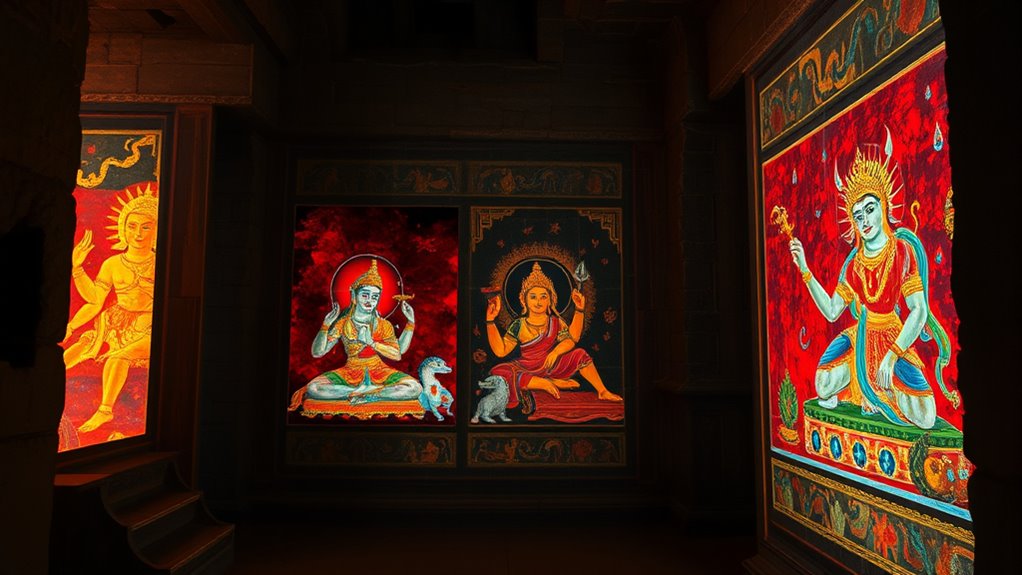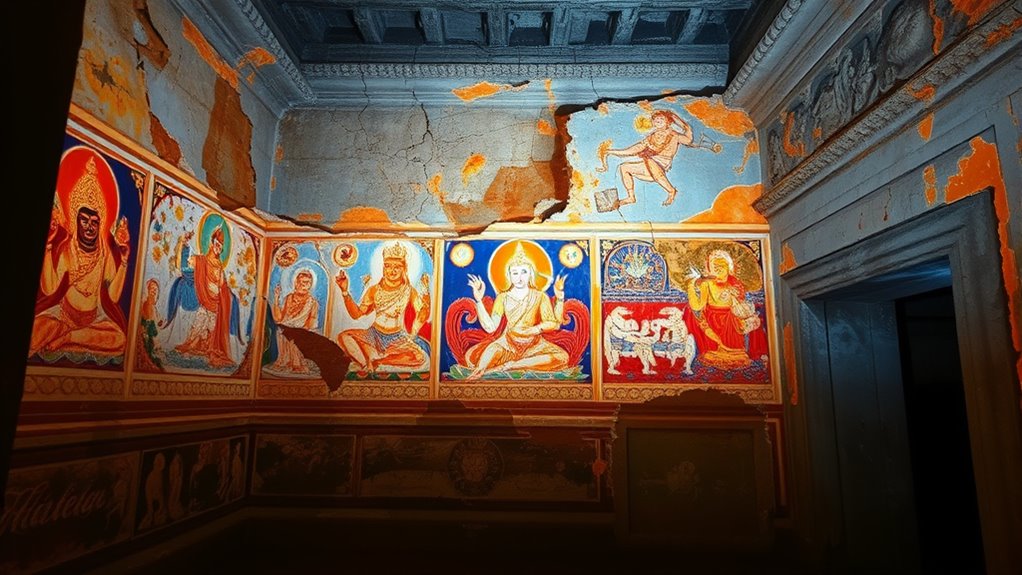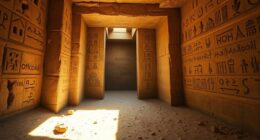Infrared imaging at Angkor Wat has uncovered hidden murals buried beneath centuries of grime, plaster, and decay. These vibrant, original paintings reveal detailed scenes from Hindu mythology, royal ceremonies, and daily life, offering new insights into ancient Khmer culture. This breakthrough shows how modern technology can unseal secrets long concealed, transforming the site from a stone monument into a vivid historical archive. Keep exploring to discover how this discovery deepens our understanding of Angkor Wat’s rich history.
Key Takeaways
- Infrared imaging uncovered ancient murals beneath Angkor Wat’s carvings, revealing vibrant colors and detailed scenes long hidden from view.
- The murals depict Hindu mythology, royal ceremonies, and daily life, offering new insights into Khmer culture and history.
- These paintings, concealed by grime and decay, provide a richer understanding of Angkor Wat’s religious and political significance.
- The discovery highlights the importance of modern archaeological technology in revealing lost cultural treasures.
- This breakthrough transforms Angkor Wat from a stone monument into a living archive of ancient art and craftsmanship.

Beneath the centuries-old stone carvings of Angkor Wat, a surprising discovery awaits: hidden paintings that reveal a new layer of its rich history. You might think the temple’s impressive bas-reliefs and intricate stone work tell the full story of its past, but recent infrared imaging has uncovered a whole new dimension. These concealed murals, long obscured by centuries of grime, plaster, and natural decay, are now coming to light, offering fresh insights into ancient art and the culture that sculpted it. This archaeological discovery could reshape what we understand about the religious and political significance of Angkor Wat during its prime.
Infrared imaging acts like a time machine, penetrating layers of dirt and material that hide the original paintings beneath the surface. As you explore these hidden artworks, you realize they’re not just remnants of decorative murals—they’re a crucial part of the temple’s historical narrative. The paintings depict scenes from Hindu mythology, royal ceremonies, and everyday life, giving you a more vivid picture of the people who built and worshipped here. In revealing these images, you see a side of Angkor Wat that was long lost to time, now brought back with modern technology.
Infrared imaging reveals hidden murals depicting Hindu myths, royal rites, and daily life, offering a vivid glimpse into Angkor Wat’s history.
This discovery is more than just about uncovering beautiful ancient art; it’s an archaeological breakthrough that expands our understanding of Khmer craftsmanship and religious practices. You notice that the paintings differ from the stone bas-reliefs in style and technique, indicating different periods or regional influences. The colors and details, once thought to be forever faded, are now visible, allowing you to appreciate the original vibrancy and artistry. It’s almost like peering into a hidden chapter of history, one that was carefully concealed, perhaps to preserve it from destruction or iconoclasm. Additionally, the use of advanced imaging technology demonstrates the importance of modern archaeological methods in uncovering lost cultural treasures.
As you walk through the temple, you realize that these findings could lead to further excavations and studies, uncovering even more about Angkor Wat’s construction and cultural context. The process of revealing these paintings also underscores the importance of advancing archaeological methods, using technology to uncover secrets long buried. With each new discovery, you’re reminded that even the most famous sites hold surprises waiting to be uncovered, deepening your appreciation for the ingenuity and spirituality of ancient civilizations. This ongoing archaeological discovery marks a significant step forward, transforming Angkor Wat from a monument of stone into a living archive of ancient art—an enduring testimony to its creators’ devotion and artistry.
Frequently Asked Questions
Are the Hidden Paintings Still Visible to the Naked Eye?
You wonder if the hidden paintings are still visible to the naked eye. Usually, their visual clarity is limited, as centuries of grime and age have obscured the pigment visibility. Infrared imaging reveals these paintings by penetrating the surface layers, but without special equipment, you likely won’t see the intricate details or vibrant colors. So, to truly appreciate them, expert analysis or imaging technology is essential, as they enhance pigment visibility beyond what your eyes can detect.
What Conservation Efforts Are in Place for These Paintings?
Imagine the delicate beauty of ancient masterpieces in a museum display, protected yet vulnerable. You’re responsible for their preservation, so restoration techniques focus on gentle cleaning and climate control to prevent damage. Experts also monitor environmental conditions constantly. These efforts ensure the paintings survive for future generations, blending cutting-edge technology with traditional methods. Your role in conservation safeguards this priceless heritage, allowing visitors to marvel at history’s silent stories.
How Does Infrared Imaging Differentiate Original Pigments?
Infrared imaging helps you differentiate original pigments by using spectral analysis to detect their unique light absorption and reflection properties. This technique allows you to identify specific pigments based on their spectral signatures, even beneath layers of paint or plaster. With pigment identification, infrared imaging reveals details that are invisible to the naked eye, enabling you to better understand the artwork’s original composition and aiding conservation efforts.
Can Visitors View the Hidden Paintings Directly?
You can’t view the hidden paintings directly because of preservation challenges that require specialized equipment. Ancient techniques used in the original artwork make it difficult for the naked eye to see these images, which is why infrared imaging is essential. This technology helps protect the site’s integrity while revealing the art beneath. So, while you can’t see the paintings firsthand, guided tours and exhibitions showcase these discoveries, ensuring preservation and public appreciation.
Will the Paintings’ Locations Be Made Accessible to Researchers?
You might wonder if researchers will gain access to the paintings’ locations. Given the restoration challenges, authorities are carefully considering how to balance preservation with archaeological significance. Access will likely be granted under strict conditions to prevent damage, ensuring that experts can study these hidden artworks. This approach helps protect the site’s integrity while allowing ongoing research, ultimately enriching our understanding of Angkor Wat’s historical and cultural importance.
Conclusion
You’ve uncovered Angkor Wat’s astonishing array of ancient artistry, where hidden hues hide behind historic walls. Infrared imaging invites you to imagine intricate images, inspiring your curiosity and fascination. As these timeless treasures are revealed, remember that history’s hidden hints hold countless clues, enthralling your mind. So, step softly into this stunning story, and let the silent splendor of secret paintings speak to your soul, sparking a sense of wonder and wanderlust within.









